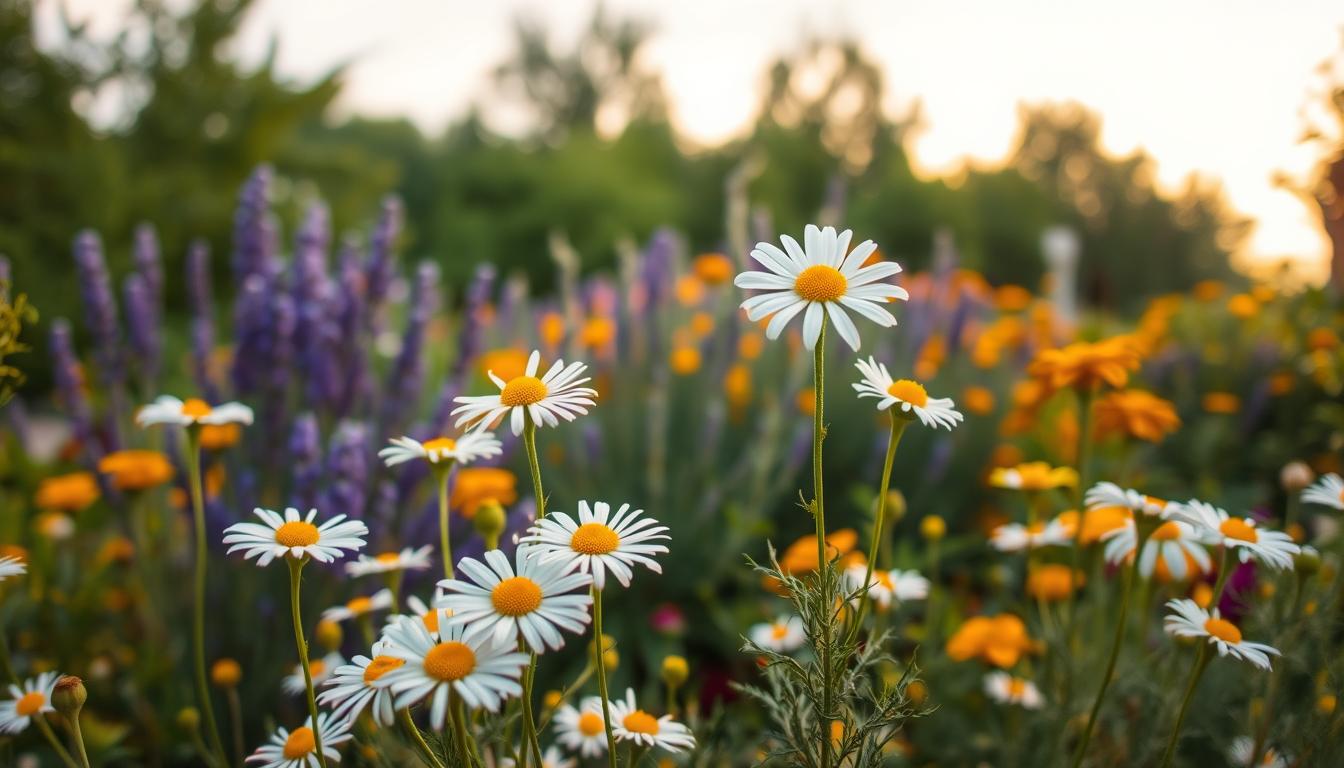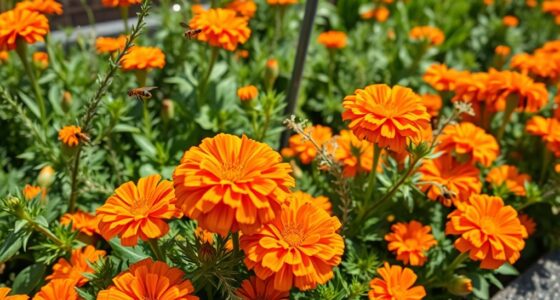Imagine stepping into your garden, the warm sun kissing your skin, and the delightful scent of chamomile wafting through the air. This cheerful little flower does more than just look good; it nurtures its neighbors and fosters a thriving garden ecosystem. By incorporating chamomile companion plants, you unlock a harmonious relationship between various species, enhancing growth, flavor, and even your own gardening joy. Whether you’re a seasoned green thumb or a curious beginner, learning about the best companion plants for chamomile can lead to a flourishing oasis filled with life and color.
Key Takeaways
- Chamomile serves as a beneficial ally in your garden.
- Consider pairing chamomile with various plants for improved growth.
- Enhancing flavors and attracting beneficial insects are key benefits.
- Discover a blend of herbs, flowers, and vegetables that flourish alongside chamomile.
- Avoid certain plants that may hinder chamomile’s growth.
What Are Companion Plants?
Companion planting is a gardening method that involves growing different plants together to provide mutual benefits. This practice encourages a more productive garden while creating a vibrant ecosystem. Gardeners often seek out effective pairings that maximize growth, deter pests, and improve soil health. Understanding this concept can elevate your gardening experience and results.
Understanding Companion Planting
At its core, companion planting employs natural relationships between plants to optimize growth. Some plants can help each other thrive by providing shade, structural support, or nutrients. Others protect against pests or enhance flavors, making this a valuable technique for garden enthusiasts. Utilizing effective gardening tips can ensure you select the right plant combinations to achieve a flourishing garden, maximizing the benefits of companion planting.
Benefits of Companion Planting
The advantages of companion planting extend beyond simply sharing space. These partnerships can lead to:
- Increased yield: Some plant combinations significantly boost overall harvests.
- Reduced pest populations: Certain plants repel harmful insects, reducing the need for chemical pesticides.
- Better use of space: Efficient pairings can help you maximize garden space without overcrowding.
- Improved soil conditions: Some plants enhance soil nutrient levels or structure.
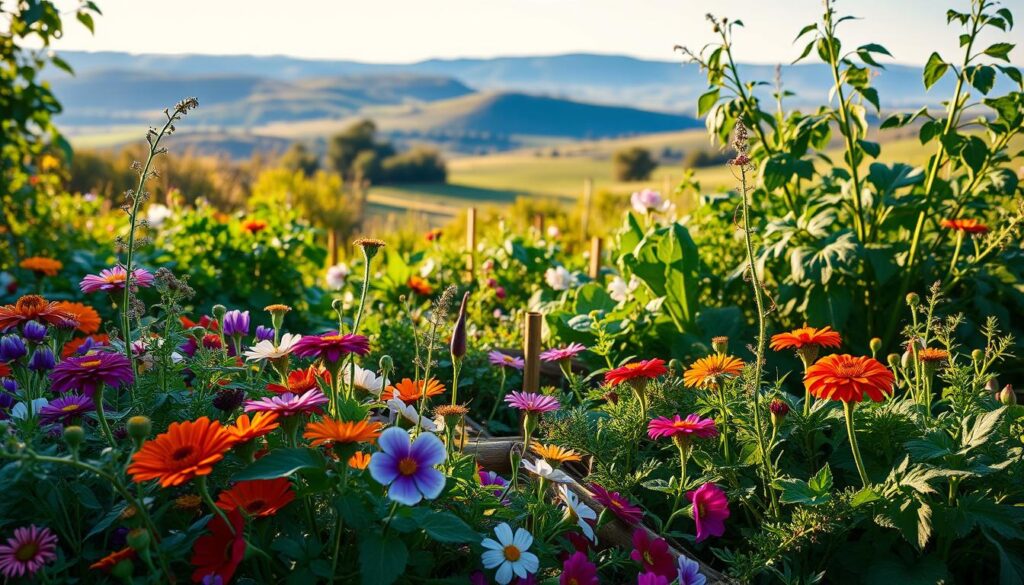
These aspects contribute to a healthier, more productive garden environment, inviting beneficial insects and encouraging biodiversity. Embrace the potential of companion planting to elevate your gardening endeavors.
Why Choose Chamomile as a Companion Plant?
Chamomile stands out as an excellent choice among chamomile herb companions due to its various benefits for the garden. This fragrant herb not only enhances the aesthetic appeal of your garden but also plays a vital role in promoting healthier plant growth. Utilizing chamomile can significantly impact your overall gardening experience, elevating both growth and flavor in the plants around it.
Enhancing Growth and Flavor
Incorporating chamomile into your garden can lead to remarkable improvements in plant growth. This herb has a unique ability to enhance taste in nearby vegetables and herbs, making them more flavorful. Furthermore, chamomile reduces the incidence of fungal infections and deters harmful pests, ensuring your plants remain robust and productive. When planted alongside your greens, chamomile acts like a natural booster, promoting optimal growth and flavor profiles.
Attracting Beneficial Insects
Another reason to choose chamomile involves its impressive capability to attract beneficial insects in the garden. Pollinators such as bees and beneficial predators like ladybugs and hoverflies find chamomile irresistible, making it a valuable ally. These insects help maintain a balanced ecosystem, controlling unwanted pests that might threaten your plants. Planting chamomile not only beautifies your garden but also fosters a thriving community of natural pest controllers.
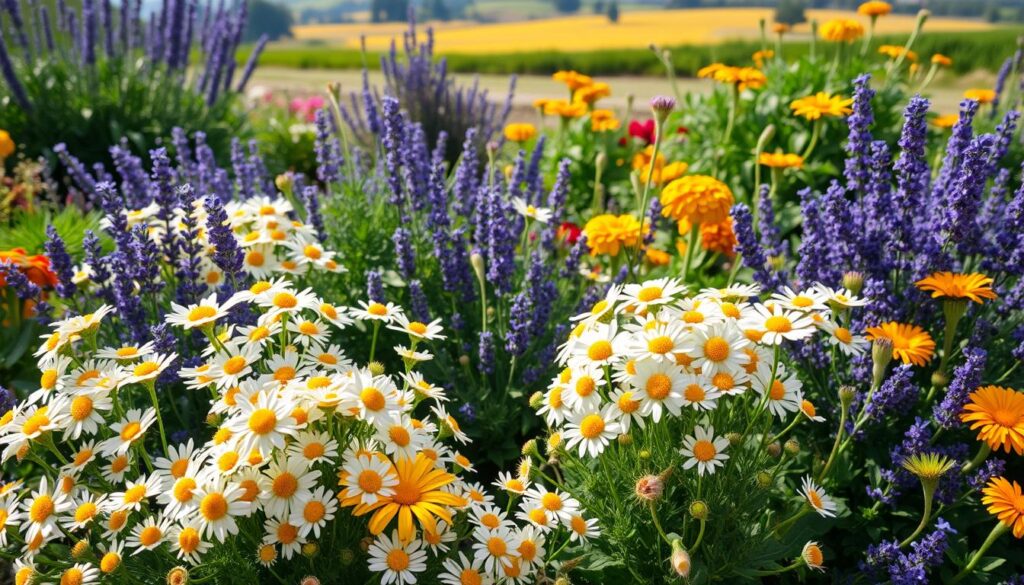
Ideal Companion Plants for Chamomile
Choosing ideal companion plants for chamomile can enhance your garden’s beauty and productivity. Some plants thrive among chamomile, offering myriad benefits such as improved growth and flavor. Below are a couple of options that make excellent companions for growing chamomile with other plants.
Basil: A Flavorful Pairing
Basil and chamomile are a delightful combination in any garden. Not only do they share similar growing conditions, but their scents can enhance each other’s growth. Basil offers a unique aromatic quality that pairs beautifully with chamomile, creating a more flavorful harvest. This synergy encourages healthy growth and helps repel pests, making it a top choice for anyone looking to cultivate chamomile.
Cabbage: Boosting Growth Together
Cabbage stands out as another ideal companion plant for chamomile. When planted alongside chamomile, cabbage benefits from the plant’s natural ability to deter pests. In return, cabbage helps provide shade that can protect chamomile during hotter days. This mutual relationship improves the flavors and overall yield of both plants, encouraging gardeners to explore more about growing chamomile with other plants.
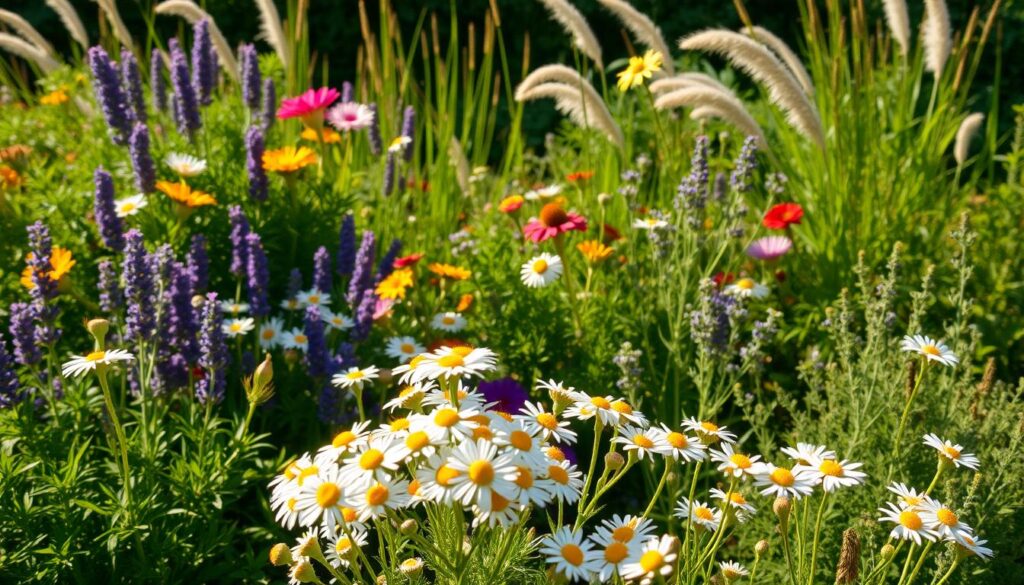
| Companion Plant | Benefits |
|---|---|
| Basil | Aromatically enhances flavor, deters pests |
| Cabbage | Provides shade, improves flavor, deters pests |
Herbs That Thrive with Chamomile
When seeking out herbs that grow well with chamomile, two standout options are parsley and mint. Both of these herbs not only flourish alongside chamomile but also contribute positively to its growth and overall health. The right chamomile plant combinations can greatly enhance both flavor and pest resistance in your garden.
Parsley: A Perfect Match
Parsley complements chamomile effectively. It benefits from the natural pest deterrent properties of chamomile, which can protect it from potential threats. Additionally, parsley and chamomile combined create a more inviting space for beneficial insects, enhancing the health of your garden. You can enjoy the rich flavor of parsley while knowing that its presence supports chamomile’s growth.
Mint: The Aroma Benefits
Mint is another excellent companion for chamomile. Its aromatic properties not only enhance your garden’s fragrance but can also improve the overall growth of chamomile. Mint helps deter pests, allowing chamomile and parsley to thrive. By planting mint alongside your chamomile, you create a harmonious environment that promotes abundance and vitality in your herb garden.
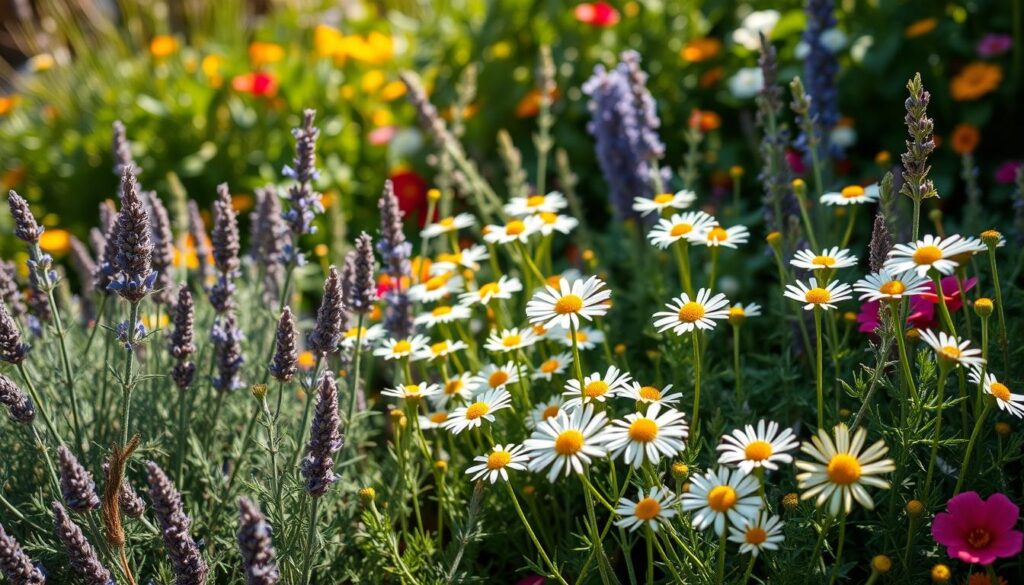
Flowers That Complement Chamomile
When considering flowers that pair with chamomile, two standouts are marigolds and nasturtiums. Both of these flowers contribute not just visual appeal but also functional benefits to your garden. They enhance the environment for chamomile, promoting a thriving garden ecosystem.
Marigolds: Pest Control Power
Utilizing marigolds for pest control can significantly benefit chamomile and surrounding plants. These vibrant flowers emit a scent that repels harmful insects like nematodes and aphids. By planting marigolds alongside chamomile, you create a protective barrier, allowing your preferred herbs to flourish without the threat of pests. This natural defense complements the growth of chamomile, giving you a healthy and productive garden.
Nasturtiums: Color and Utility
Nasturtiums offer a dual advantage in your garden. Not only do they bring a splash of color, but their benefits extend to attracting pollinators that help with plant reproduction. By integrating nasturtiums near your chamomile, you enhance the visual appeal while fostering a biodiverse environment. Their ability to deter certain pests further supports the health of your chamomile and other companion plants, ensuring a harmonious growth space.
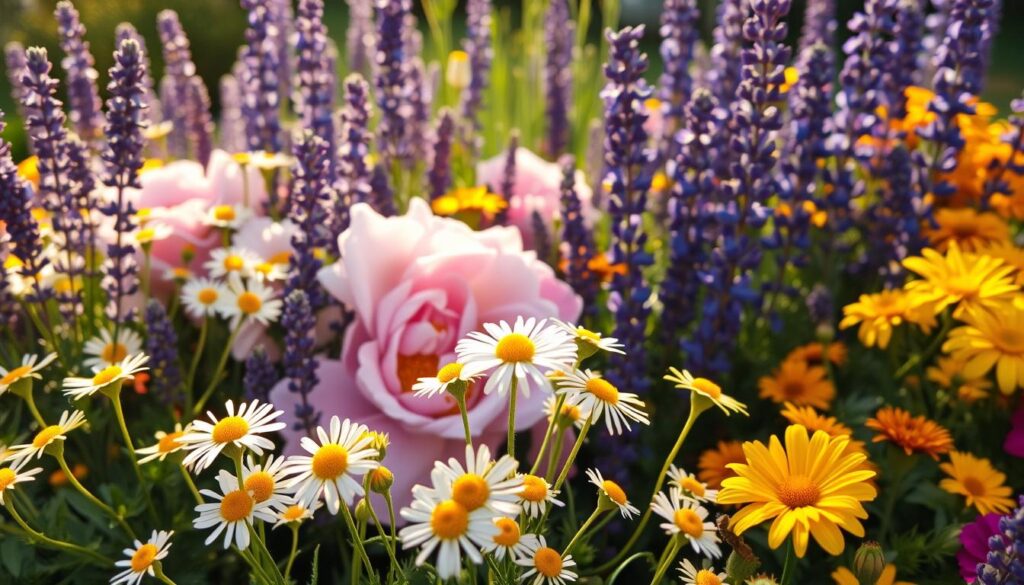
Vegetables That Pair Well with Chamomile
In the vibrant world of companion planting, vegetables suitable for chamomile can significantly enhance your garden’s productivity. Notably, tomatoes and peppers stand out as exceptional partners. These colorful vegetables thrive alongside chamomile, creating an inviting atmosphere for your gardening efforts.
Tomatoes: Flavor Enhancement
Growing chamomile with tomatoes can lead to improved flavor profiles in your harvest. The aromatic qualities of chamomile create a conducive environment that encourages robust growth and enhanced taste. Both plants also benefit from reduced pest infestations, ensuring that your tomatoes flourish without the threat of harmful insects.
Peppers: Mutual Benefits
The partnership between chamomile and peppers offers mutual advantages, promoting healthy growth patterns. These vegetables enjoy the protective effects of chamomile, leading to improved vegetable growth and a vibrant pepper yield. When combined, these plants not only beautify your garden but help each other thrive.
| Vegetable | Benefits of Pairing with Chamomile | Growing Tips |
|---|---|---|
| Tomatoes | Improved flavor and reduced pests | Ensure ample sunlight and regular watering |
| Peppers | Enhanced growth and pest protection | Provide well-drained soil and consistent moisture |

Plants to Avoid Near Chamomile
Knowing which plants to avoid with chamomile can significantly impact your gardening success. Certain plants can inhibit chamomile’s growth through various mechanisms, leading to companion plant conflicts. By identifying these unsuccessful plant pairings, you can create a healthier and more productive garden environment.
Understanding Plant Conflicts
Companion plant conflicts arise when certain plants actively hinder one another’s growth. This can occur through competition for resources, the release of allelopathic compounds, or the propagation of pests and diseases. Recognizing these conflicts is essential for encouraging the flourishing of your chamomile and its supporting plants.
Specific Plant Matches to Avoid
- Cilantro: This herb tends to have negative interactions with chamomile, leading to reduced growth.
- Fennel: Known for inhibiting the growth of many plants, fennel can create significant conflicts near chamomile.
- Carrots: While they are effective companions for many plants, carrots can struggle when planted close to chamomile.
- Potatoes: These tubers can attract pests that may adversely affect chamomile, leading to unsuccessful plant pairings.
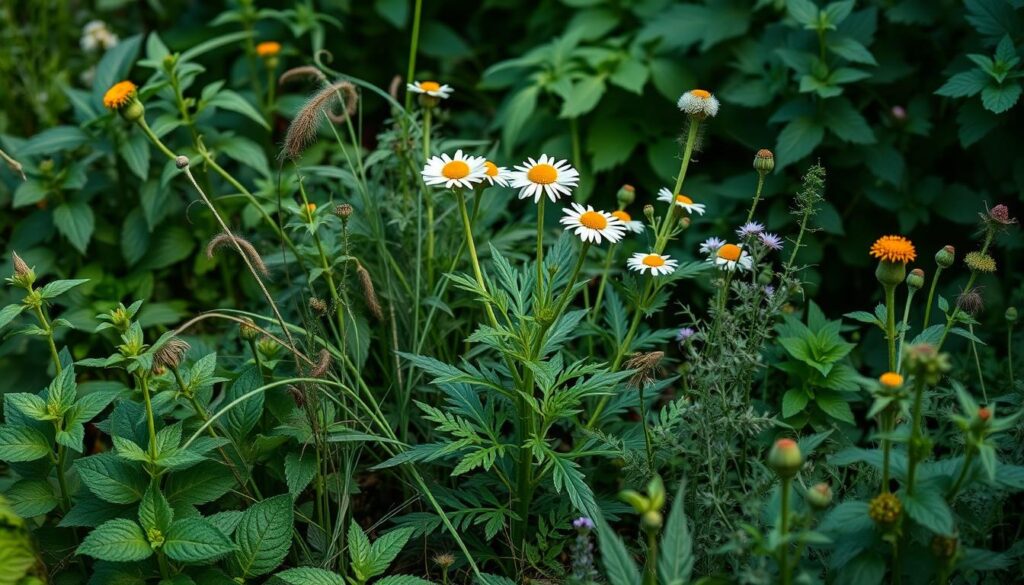
Growing Conditions for Chamomile and Companions
To cultivate healthy chamomile plants and their companion species, understanding the specific growing conditions is essential. Each component plays a vital role in optimizing growth, flavor, and overall vitality.
Soil Requirements
The ideal soil type for chamomile is well-drained, sandy loam. This type promotes excellent drainage and allows roots to develop without excess moisture. Chamomile prefers a pH level between 6.0 and 7.0, making slightly acidic to neutral soils suitable. Regularly testing your soil will ensure it maintains the proper nutrient balance for both chamomile and its plant partners.
Light and Water Needs
Chamomile thrives in full sun, requiring at least six hours of direct sunlight daily. Adequate exposure ensures robust growth and abundant flowering. When it comes to water, maintain moderate moisture; the growing chamomile conditions indicate that overwatering can lead to root rot. Allow the top inch of soil to dry out between waterings, ensuring a balanced approach to meet both light and water needs.

| Condition | Details |
|---|---|
| Soil Type | Well-drained, sandy loam |
| pH Level | 6.0 to 7.0 (slightly acidic to neutral) |
| Sunlight | At least 6 hours of direct sunlight |
| Watering | Moderate moisture; allow soil to dry between waterings |
How to Plant Chamomile with Companion Plants
Successfully integrating chamomile with companion plants requires careful attention to spacing and timing. Implementing optimal spacing enhances airflow and light access, crucial for healthy growth. Following a well-structured planting schedule ensures that each plant flourishes, contributing to a vibrant garden.
Spacing Considerations
When planting chamomile with companions, aim for optimal spacing that promotes growth while avoiding overcrowding. Here are some recommendations for spacing:
- Chamomile: 8-12 inches apart to give them space to spread.
- Basil: 12-18 inches apart from chamomile, ensuring ample sunlight.
- Tomatoes: 24-36 inches apart to allow for vine growth.
Maintaining this spacing encourages healthy root development and prevents competition for nutrients. This consideration is vital for a thriving companion planting strategy.
Timing for Planting Together
Establishing a reliable planting schedule is essential for your garden’s success. It is best to plant chamomile with companions in the spring after the last frost. Here’s a suggested timeline:
| Plant | Best Planting Time |
|---|---|
| Chamomile | April to June |
| Basil | Late May to June |
| Tomatoes | Late April to May |
Adhering to this planting schedule aligns each species’ growth cycle, fostering a synergistic relationship among your plants. Timing plays a crucial role in ensuring all your plants thrive together, making your garden both beautiful and productive.
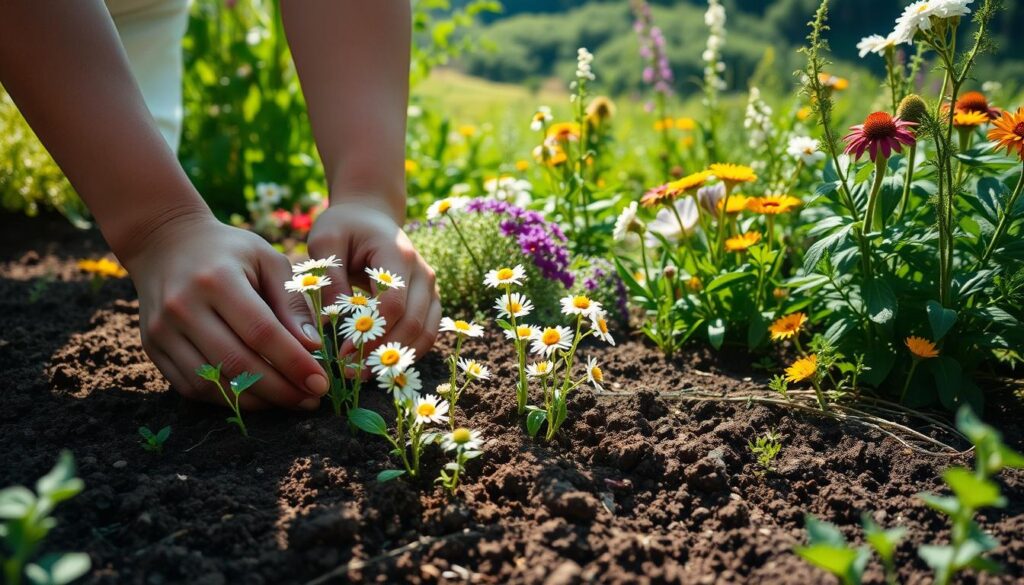
Common Pests and Disease Management
Pests and diseases can pose a significant threat to your chamomile plants and the broader garden ecosystem. Identifying common garden pests is essential for effective chamomile pest management. By staying vigilant, you can quickly recognize trouble-makers that may harm your plants. These culprits often include aphids, spider mites, and whiteflies, which can damage not only chamomile but also its companion plants.
Identifying Trouble-Makers
Awareness of the signs of common garden pests will enable you to act promptly. Look for discoloration of leaves, stunted growth, or the presence of tiny insects on your plants. Observing these indicators will help you recognize issues before they escalate. Keeping a close eye on your garden helps maintain the health of chamomile and its neighboring plants.
Organic Control Methods
To protect your garden naturally, consider various organic pest control methods. Introducing beneficial insects such as ladybugs can help manage aphid populations. Neem oil sprays work effectively against a range of common pests while remaining safe for your plants. Planting garlic or using diatomaceous earth can further deter harmful insects without resorting to harsh chemicals. Embracing these organic strategies aligns with sustainable gardening practices, ensuring your chamomile and its companions thrive together.
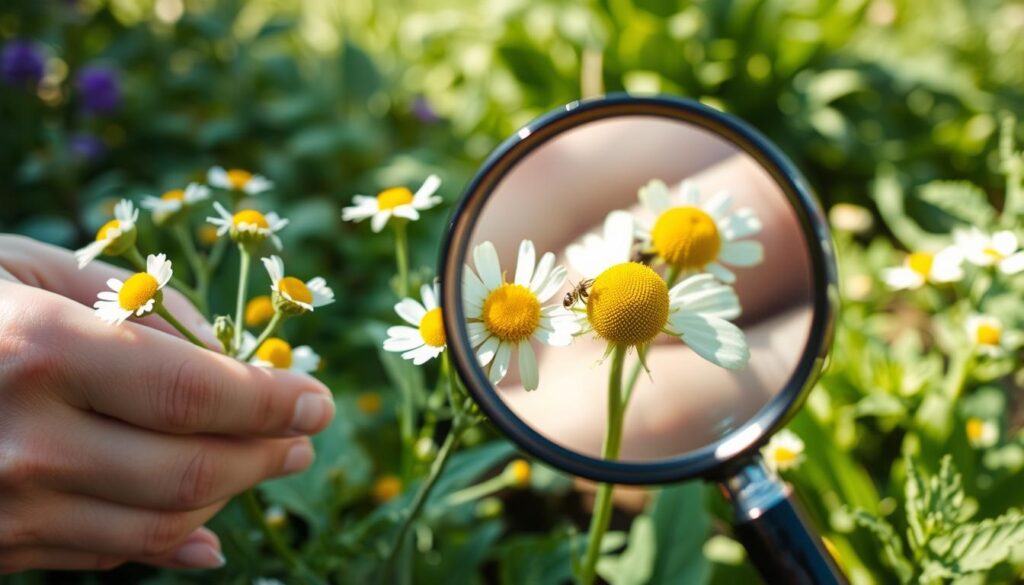
Harvesting and Using Chamomile
Harvesting chamomile at the right moment is essential for ensuring maximum flavor and potency. Timing is crucial, as flowers should be picked when they are fully open. This stage allows for the highest concentration of essential oils, making your chamomile more aromatic and flavorful. With proper harvesting techniques, you can enjoy the numerous culinary uses of chamomile, as well as its well-known medicinal properties.
Best Practices for Harvesting
To harvest chamomile effectively, follow these best practices:
- Choose a dry morning to pick the flowers, as moisture can affect their quality.
- Use scissors or pruners to cut the flower heads, leaving some leaves for continued growth.
- Harvest in small batches to ensure the flowers are fresh and vibrant.
Culinary and Medicinal Uses
The culinary uses of chamomile are diverse. It serves as an excellent addition to teas, desserts, and even salads. You can create soothing chamomile-infused honey or use the dried flowers in baking. This versatile herb is celebrated for its medicinal properties as well, being known to aid in digestion and reduce anxiety. Incorporate chamomile into your daily routine to harness its calming effects.
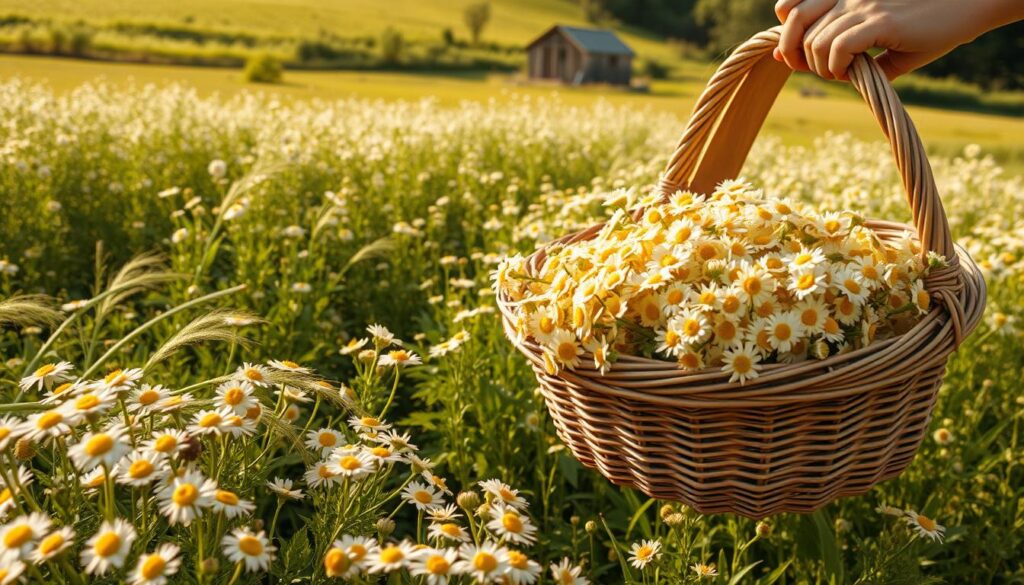
Seasonal Care for Chamomile and Companions
Caring for your chamomile and its companion plants throughout the seasons ensures healthy growth and abundant blooms. Each season requires specific maintenance practices to promote vitality and resilience. The following tips outline key strategies for maintaining chamomile plants during winter and summer.
Winter Care Tips
During the colder months, protecting your chamomile plants is essential. Here are several winter care strategies:
- Mulching: Apply a layer of organic mulch around the base of the plants. This helps insulate the soil and retain moisture.
- Frost Protection: Consider using row covers or cloth to shield the plants from harsh frost. This can help extend their survival through cold snaps.
- Minimal Watering: Reduce watering in winter, as chamomile requires less moisture when temperatures drop.
Summer Maintenance
Summer is the season for growth and care. Focus on these maintenance tips to ensure your chamomile thrives:
- Regular Watering: Water deeply but infrequently. Chamomile prefers moist, well-draining soil.
- Pruning: Trim spent flowers to encourage new growth and extended blooming periods.
- Fertilizing: Use a balanced, organic fertilizer to provide essential nutrients throughout the growing season.
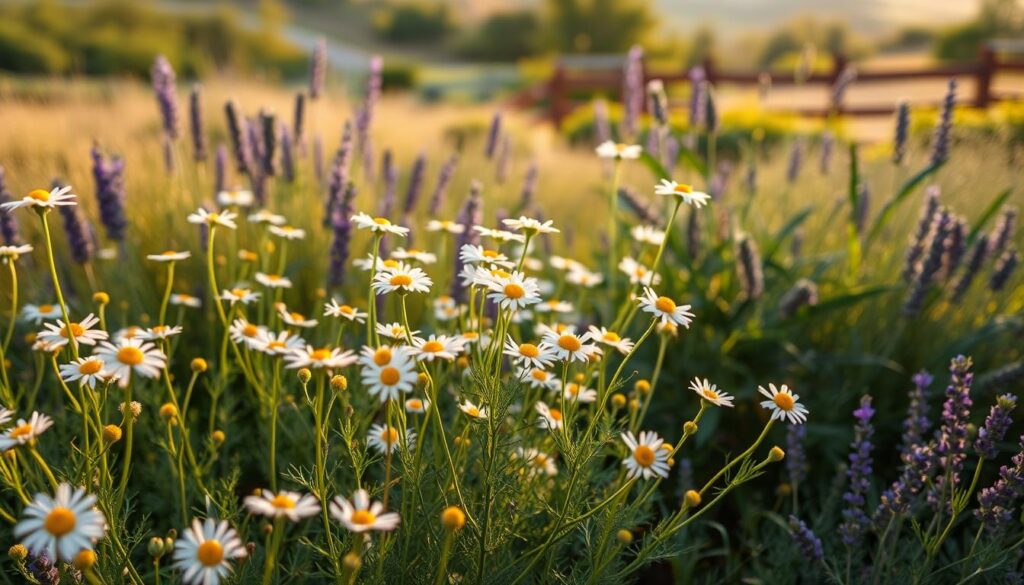
Creating a Chamomile Companion Garden
Designing a chamomile garden can be an exciting and rewarding endeavor. A well-planned companion planting layout enhances the growth of chamomile and its neighboring plants, leading to a vibrant and productive garden. Taking the time to carefully consider space management will allow you to optimize your garden’s potential, ensuring every plant flourishes.
Planning Your Layout
Begin by sketching a rough layout of your garden. Focus on grouping chamomile with its ideal companions. For instance, place basil and parsley close to chamomile, as these herbs thrive together. Ensure adequate spacing between plants to prevent overcrowding, which can hinder growth.
Maximizing Space and Resources
Utilizing vertical space can be beneficial in a companion garden. Install trellises or vertical planters for climbing plants. Besides herbs and flowers, consider interspersing taller plants with chamomile to create varied layers, enhancing both aesthetics and productivity.
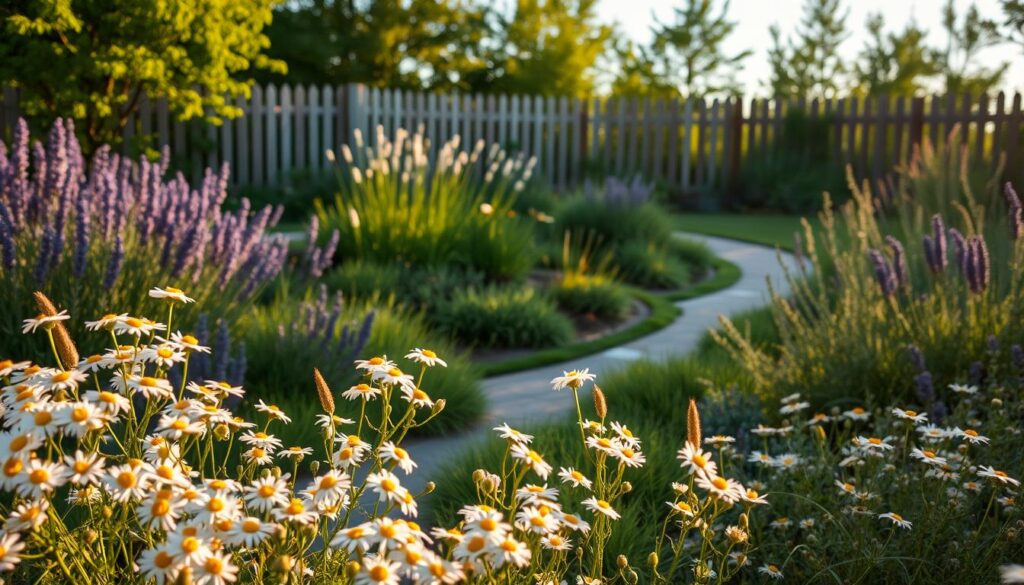
| Companion Plant | Benefits | Space Requirements |
|---|---|---|
| Basil | Enhances flavor and growth | 18 inches apart |
| Parsley | Supports health and aroma | 12 inches apart |
| Marigolds | Pest deterrent | 12 inches apart |
| Nasturtiums | Attracts beneficial insects | 18 inches apart |
Carefully considering these aspects will help you create a flourishing chamomile companion garden that maximizes your available space and resources effectively.
Conclusion: Your Chamomile Companion Strategy
As you venture into the world of companion planting, incorporating chamomile into your garden strategy offers numerous benefits. This aromatic herb not only enhances the growth and flavor of your plants but also attracts valuable pollinators and beneficial insects, creating a thriving garden ecosystem. By leveraging the advantages of companion planting, you can cultivate a healthier and more productive garden.
It’s important to remember that every garden is unique, and part of the joy of gardening is to experiment with plants. Exploring various combinations beyond the main companions can lead to surprising results, so don’t hesitate to try different pairings with chamomile. Each season presents an opportunity to reassess your chamomile planting strategy and to adjust based on your observations and experiences.
Ultimately, your journey into companion planting will be enriched by these discoveries. So, grab your trowel and start mixing and matching those plants. The rewards of a vibrant, flourishing garden are waiting for you, just a planting season away!
